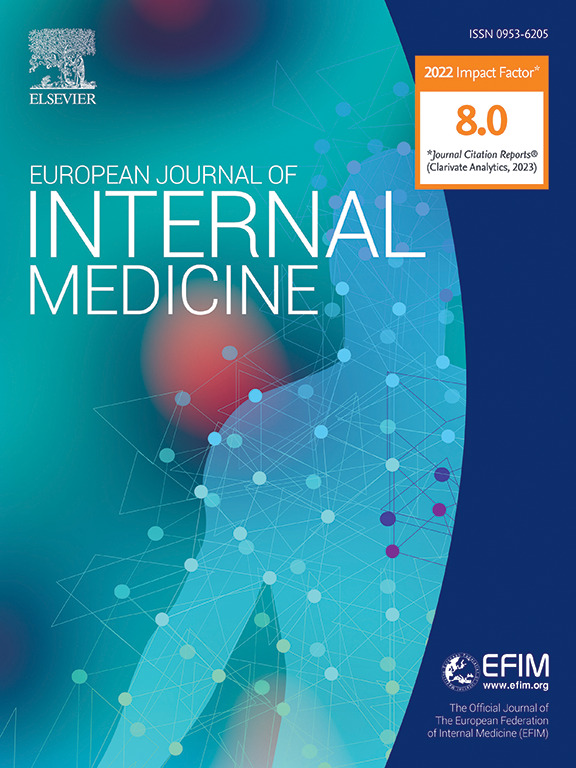药物性低钠血症的临床护理。
IF 6.1
2区 医学
Q1 MEDICINE, GENERAL & INTERNAL
引用次数: 0
摘要
目的:在过去的几十年里,对先前描述的关联的理解的进展对低钠血症的诊断和检查具有重要意义。此外,可能影响钠平衡和水平衡的新药物组也在不断发展。本综述的目的是总结目前临床护理中药物性低钠血症的证据。方法:我们在PubMed检索2008年1月1日至2024年9月2日的“不适当的ADH综合征/化学诱导”[Mesh]或“不适当的ADH综合征/诊断”[Mesh]或(“低钠血症/化学诱导”[Mesh]或“低钠血症/诊断”[Mesh])。总共发现并审查了2003篇文章。随后对本文所引用的相关文章进行了追溯和审查。结果:与低钠血症相关的药物,包括选择性血清素再摄取抑制剂、抗精神病药物、抗癫痫药物和质子泵抑制剂,通常在治疗开始后不久引起低钠血症。噻嗪类利尿剂是引起药物性低钠血症的罪魁祸首,在开始使用后的最初几周内,低钠血症的风险最高,随后逐渐降低至稳定,但在3个月左右仍会升高。一些促进负水平衡的药物,如利尿剂、锂和钠-葡萄糖共转运蛋白-2抑制剂,似乎可以降低低钠血症的风险。免疫检查点抑制剂治疗与继发性和原发性皮质醇缺乏导致低钠血症的垂体炎和肾上腺炎风险增加相关。结论:对于大多数与低钠血症相关的药物,包括噻嗪类药物,其因果关系与新开始治疗密切相关。有必要进一步研究低钠血症与新开发的药物如钠-葡萄糖共转运蛋白-2抑制剂和免疫检查点抑制剂之间的关系。本文章由计算机程序翻译,如有差异,请以英文原文为准。
Drug-induced hyponatremia in clinical care
Purpose
Over the last decades, advances in understanding of previously described associations have important implications for diagnosis and workup of hyponatremia. In addition, new drug groups potentially affecting sodium balance and water homeostasis have evolved. The aim of this review is to summarize current evidence on drug-induced hyponatremia in clinical care.
Methods
We searched PubMed using the string "Inappropriate ADH Syndrome/chemically induced"[Mesh] OR "Inappropriate ADH Syndrome/diagnosis"[Mesh]) OR ("Hyponatremia/chemically induced"[Mesh] OR "Hyponatremia/diagnosis"[Mesh]), January 1st, 2008, to September 2nd 2024. In total 2003 articles were found and reviewed. Relevant articles referenced herein were subsequently traced backwards and also reviewed.
Results
Drugs associated with hyponatremia, including selective serotonin reuptake inhibitors, antipsychotics, antiepileptic drugs and proton pump inhibitors, typically cause hyponatremia shortly after initiation of treatment. For thiazide diuretics, the number one culprit in drug-induced hyponatremia, the risk for hyponatremia is highest the first weeks after initiation and then gradually decreases to a stable but still increased level after around 3 months. Several drugs that promote a negative water balance such as loop diuretics, lithium and of sodium-glucose cotransporter-2 inhibitors appear to decrease the risk for hyponatremia. Treatment with immune checkpoint inhibitors is associated with an increased risk of hypophysitis and adrenalitis resulting in hyponatremia due to secondary and primary cortisol deficiency.
Conclusion
For most drugs associated with hyponatremia, including thiazides, the cause-effect relationship is tightly linked to newly initiated treatment. Further research is warranted to characterize the association between hyponatremia and newly developed drugs such as sodium-glucose cotransporter-2 inhibitors and immune checkpoint inhibitors.
求助全文
通过发布文献求助,成功后即可免费获取论文全文。
去求助
来源期刊
CiteScore
9.60
自引率
6.20%
发文量
364
审稿时长
20 days
期刊介绍:
The European Journal of Internal Medicine serves as the official journal of the European Federation of Internal Medicine and is the primary scientific reference for European academic and non-academic internists. It is dedicated to advancing science and practice in internal medicine across Europe. The journal publishes original articles, editorials, reviews, internal medicine flashcards, and other relevant information in the field. Both translational medicine and clinical studies are emphasized. EJIM aspires to be a leading platform for excellent clinical studies, with a focus on enhancing the quality of healthcare in European hospitals.

 求助内容:
求助内容: 应助结果提醒方式:
应助结果提醒方式:


